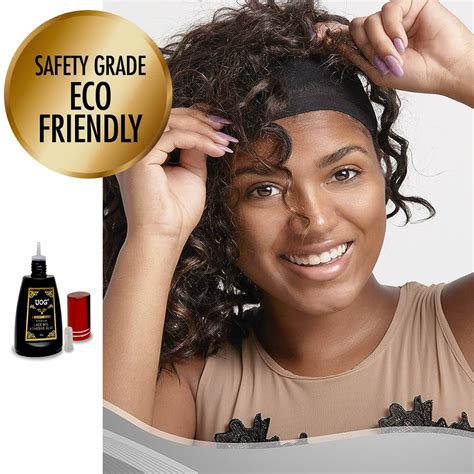Introduction

Lace wigs have become increasingly popular due to their natural appearance and versatility. However, achieving a secure and long-lasting hold requires the right adhesive. In this comprehensive guide, we delve into the world of lace wig glue, exploring the different types, application techniques, and essential factors to consider.
Types of Lace Wig Glue
The adhesive market offers a wide range of lace wig glues, each with its own unique properties. Here are some of the most common types:
-
Water-Based Glue: These glues are the most beginner-friendly and affordable. They create a flexible bond that is easy to apply and remove.
-
Alcohol-Based Glue: With their quick drying time, alcohol-based glues provide a stronger hold and are ideal for wearers with oily scalp or excessive sweating.
-
Solvent-Based Glue: Offering the strongest adhesion, solvent-based glues are also the most difficult to remove. They are typically used by experienced lace wig wearers.
How to Choose the Right Lace Wig Glue
Selecting the perfect lace wig glue depends on several factors:
-
Hair Type: Fine or delicate hair requires a gentle adhesive, while thick or coarse hair can withstand stronger glues.
-
Scalp Type: Oily scalps need a glue that can withstand moisture, while sensitive scalps may respond better to hypoallergenic options.
-
Application Expertise: Beginners should start with water-based glues, while experienced wearers can explore solvent-based options.
Step-by-Step Application Guide
-
Prepare the Surface: Cleanse the scalp and apply a thin layer of adhesive remover to remove any residue or oils.
-
Apply the Glue: Using a fine-tipped brush or wipe, apply the glue in thin strips along the hairline. Allow it to become tacky before applying the lace.
-
Press the Lace: Gently press the lace onto the scalp, starting from the front and working backwards. Hold firmly for a few minutes to secure the bond.
-
Secure the Hold: Use a blow dryer on a low setting to help the glue set faster. Avoid excessive heat, as it can damage the hair or scalp.
Troubleshooting Common Problems
-
Loose Lace: If the lace wig becomes loose, reapply a small amount of glue to the affected areas.
-
Residue Buildup: Avoid over-application, as this can lead to residue buildup and skin irritation. Use a gentle adhesive remover to clean excess glue.
-
Scalp Sensitivity: Some glues can cause allergic reactions. If you experience any irritation, discontinue use and consult a dermatologist.
Lace Wig Glue FAQs
1. How long does lace wig glue last?
The longevity of lace wig glue depends on the type of glue, the application technique, and the wearer’s individual scalp chemistry. On average, most glues last between 2 and 6 weeks.
2. Can I swim while wearing a lace wig glued down?
It is generally not recommended to swim with a lace wig glued down. The water can weaken the bond and cause the lace to loosen.
3. How do I remove lace wig glue?
Use an adhesive remover specifically designed for lace wigs. Apply a small amount to the edges of the lace and gently lift it away. Do not pull or tug, as it can damage the hair.
The Future of Lace Wig Glue
As the popularity of lace wigs continues to grow, manufacturers are constantly innovating to improve lace wig glue formulations. Expect to see new developments in:
- Hypoallergenic options: Glues that are less likely to cause allergic reactions.
- Long-lasting adhesives: Glues that offer even longer hold times.
- Quick-drying formulas: Glues that reduce application time and improve convenience.
Customers’ Insights
Motivation:
Customers are eager for a lace wig glue that provides a secure hold while protecting their natural hair and scalp. They seek products that are easy to apply and remove without leaving behind residue.
Pain Points:
Wearers frequently experience frustration with glues that fail to last or cause skin irritation. They want to find a solution that eliminates the need for frequent reapplication or costly repairs.
Share Your Thoughts:
Have you used lace wig glue before? What were your experiences? What improvements would you like to see in the future? Share your thoughts in the comments below.
Conclusion
Lace wig glue is an essential component for achieving a flawless and long-lasting lace wig hold. By understanding the different types, application techniques, and factors to consider, you can choose the right glue for your specific needs. With proper care and a reliable adhesive, you can enjoy a beautiful and secure lace wig experience.
Tables:
Table 1: Types of Lace Wig Glue
| Type | Properties |
|---|---|
| Water-Based | Flexible, easy to apply, affordable |
| Alcohol-Based | Stronger hold, quick drying |
| Solvent-Based | Strongest adhesion, difficult to remove |
Table 2: Lace Wig Glue Selection Guide
| Factor | Consideration |
|---|---|
| Hair Type | Fine hair requires gentle glues, thick hair can withstand stronger glues |
| Scalp Type | Oily scalps need moisture-resistant glues, sensitive scalps need hypoallergenic options |
| Application Expertise | Beginners should start with water-based glues, experienced wearers can explore solvent-based options |
Table 3: Troubleshooting Lace Wig Glue Problems
| Problem | Solution |
|---|---|
| Loose Lace | Reapply glue to affected areas |
| Residue Buildup | Use a gentle adhesive remover to clean excess glue |
| Scalp Sensitivity | Discontinue use and consult a dermatologist |
Table 4: Potential Future Developments in Lace Wig Glue
| Development | Benefit |
|---|---|
| Hypoallergenic options | Less risk of allergic reactions |
| Long-lasting adhesives | Increased hold times |
| Quick-drying formulas | Improved convenience and reduced application time |
